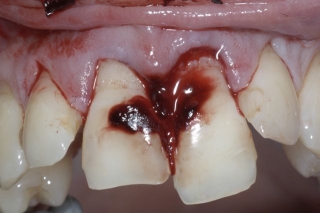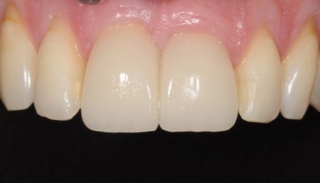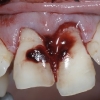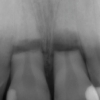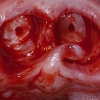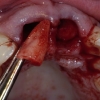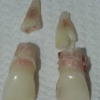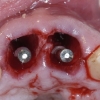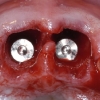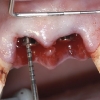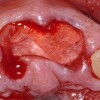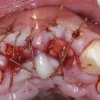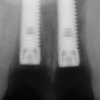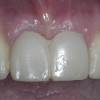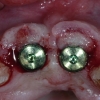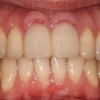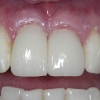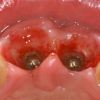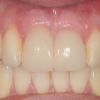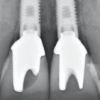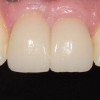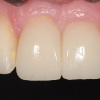Case report
This patient suffered a traumatic elbow blow to his upper incisors during a football match. He was seen immediately by his dentist who assessed the severity of the injury and referred him immediately to our office for evaluation.
Teeth #8 and 9 had root fractures and were displaced palately. A treatment plan consisting of extraction of teeth #8 and 9 followed with immediate placement of dental implants were discussed. The supporting bone and soft tissue were healthy and intact which offered a great indication for immediate dental implants approach.
Treatment
1. Teeth #8 and #9 were extracted atraumatically using careful elevation techniques. The buccal plate was noted to be thin, but intact.
2. The implant site was initially marked with a round bur, positioned on the mid palatal aspect of the socket, half way between the crest of bone and the apex.
3. The pilot and subsequent drills were placed so that the implant is positioned more palatally, emerging just lingual to the incisal edge.
4. Zimmer 3.7 mm implants were placed. The sites were relatively narrow and 3.7 mm implants provided adequate inter-implant distance (at least 3 mm) and 1.5 mm from the adjacent roots.
5. The implants were positioned with the platform 3 mm apical to the mid-buccal gingival margin.
6. Bone graft was placed on the buccal aspect of the implants, along with GTR membrane and primary closure.
7. Patient used a transitional prosthesis for 4 months to achieve complete bone healing and implant integration before restorations.
8. Following exposure, an implant-supported provisional restoration was placed and maintained for about 3 months. This allowed shaping the soft tissue and also evaluating the aesthetic requirements of the final prosthesis.
9. Full ceramic abutments and crowns were placed as the final prosthesis.
Success factors:
1. Atraumatic extractions with preservation of surrounding bone and soft tissues
2. Immediate dental implants
3. Palatal positioning of the implants
4. Preserving labial tissue architecture with bone graft
5. Implant supported provisional restorations for three months to shape and guide soft tissue
6. Ceramic abutments and crowns for optimal aesthetics
7. Great patient compliance with treatment and the multiple visits required for tissue management
